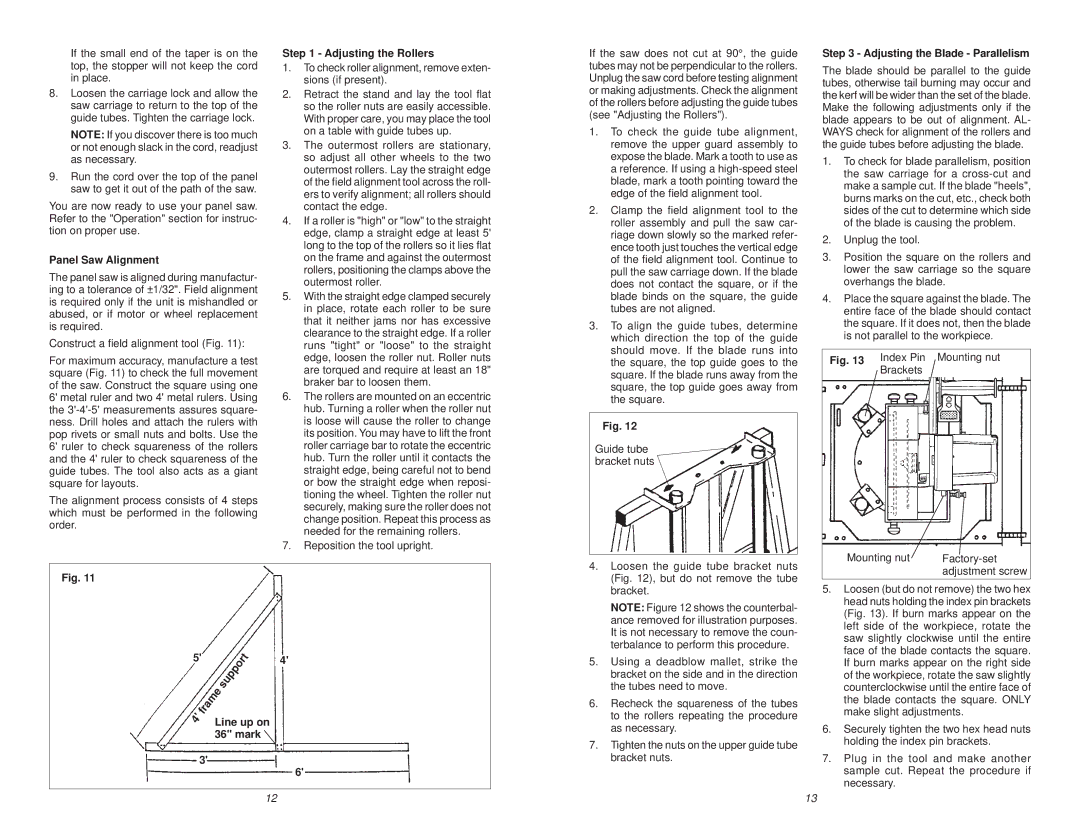
If the small end of the taper is on the top, the stopper will not keep the cord in place.
8.Loosen the carriage lock and allow the saw carriage to return to the top of the guide tubes. Tighten the carriage lock.
NOTE: If you discover there is too much or not enough slack in the cord, readjust as necessary.
9.Run the cord over the top of the panel saw to get it out of the path of the saw.
You are now ready to use your panel saw. Refer to the "Operation" section for instruc- tion on proper use.
Panel Saw Alignment
The panel saw is aligned during manufactur- ing to a tolerance of ±1/32". Field alignment is required only if the unit is mishandled or abused, or if motor or wheel replacement is required.
Construct a field alignment tool (Fig. 11):
For maximum accuracy, manufacture a test square (Fig. 11) to check the full movement of the saw. Construct the square using one 6' metal ruler and two 4' metal rulers. Using the
The alignment process consists of 4 steps which must be performed in the following order.
Step 1 - Adjusting the Rollers
1.To check roller alignment, remove exten- sions (if present).
2.Retract the stand and lay the tool flat so the roller nuts are easily accessible. With proper care, you may place the tool on a table with guide tubes up.
3.The outermost rollers are stationary, so adjust all other wheels to the two outermost rollers. Lay the straight edge of the field alignment tool across the roll- ers to verify alignment; all rollers should contact the edge.
4.If a roller is "high" or "low" to the straight edge, clamp a straight edge at least 5' long to the top of the rollers so it lies flat on the frame and against the outermost rollers, positioning the clamps above the outermost roller.
5.With the straight edge clamped securely in place, rotate each roller to be sure that it neither jams nor has excessive clearance to the straight edge. If a roller runs "tight" or "loose" to the straight edge, loosen the roller nut. Roller nuts are torqued and require at least an 18" braker bar to loosen them.
6.The rollers are mounted on an eccentric hub. Turning a roller when the roller nut is loose will cause the roller to change its position. You may have to lift the front roller carriage bar to rotate the eccentric hub. Turn the roller until it contacts the straight edge, being careful not to bend or bow the straight edge when reposi- tioning the wheel. Tighten the roller nut securely, making sure the roller does not change position. Repeat this process as needed for the remaining rollers.
7.Reposition the tool upright.
If the saw does not cut at 90°, the guide tubes may not be perpendicular to the rollers. Unplug the saw cord before testing alignment or making adjustments. Check the alignment of the rollers before adjusting the guide tubes (see "Adjusting the Rollers").
1.To check the guide tube alignment, remove the upper guard assembly to expose the blade. Mark a tooth to use as a reference. If using a
2.Clamp the field alignment tool to the roller assembly and pull the saw car- riage down slowly so the marked refer- ence tooth just touches the vertical edge of the field alignment tool. Continue to pull the saw carriage down. If the blade does not contact the square, or if the blade binds on the square, the guide tubes are not aligned.
3.To align the guide tubes, determine which direction the top of the guide should move. If the blade runs into the square, the top guide goes to the square. If the blade runs away from the square, the top guide goes away from the square.
Fig. 12
Guide tube bracket nuts
Step 3 - Adjusting the Blade - Parallelism
The blade should be parallel to the guide tubes, otherwise tail burning may occur and the kerf will be wider than the set of the blade. Make the following adjustments only if the blade appears to be out of alignment. AL- WAYS check for alignment of the rollers and the guide tubes before adjusting the blade.
1.To check for blade parallelism, position the saw carriage for a
2.Unplug the tool.
3.Position the square on the rollers and lower the saw carriage so the square overhangs the blade.
4.Place the square against the blade. The entire face of the blade should contact the square. If it does not, then the blade is not parallel to the workpiece.
Fig. 13 Index Pin Mounting nut Brackets
Fig. 11
5'4'
Line up on 36" mark 
3'
6'
4.Loosen the guide tube bracket nuts (Fig. 12), but do not remove the tube bracket.
NOTE: Figure 12 shows the counterbal- ance removed for illustration purposes. It is not necessary to remove the coun- terbalance to perform this procedure.
5.Using a deadblow mallet, strike the bracket on the side and in the direction the tubes need to move.
6.Recheck the squareness of the tubes to the rollers repeating the procedure as necessary.
7.Tighten the nuts on the upper guide tube bracket nuts.
Mounting nut | |
| adjustment screw |
5.Loosen (but do not remove) the two hex head nuts holding the index pin brackets (Fig. 13). If burn marks appear on the left side of the workpiece, rotate the saw slightly clockwise until the entire face of the blade contacts the square. If burn marks appear on the right side of the workpiece, rotate the saw slightly counterclockwise until the entire face of the blade contacts the square. ONLY make slight adjustments.
6.Securely tighten the two hex head nuts holding the index pin brackets.
7.Plug in the tool and make another sample cut. Repeat the procedure if necessary.
12 | 13 |
